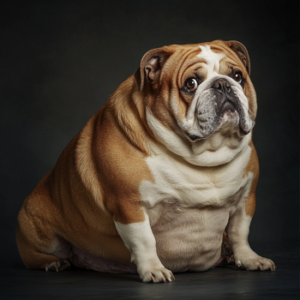Obesity in Dogs
Obesity in dogs is an increasing and alarming health problem that affects a large portion of the canine population worldwide. It is defined as excess body fat sufficient to impair the health or well-being of the dog.
This phenomenon not only significantly reduces the quality of life for our four-legged friends but can also shorten their lifespan due to various health complications associated with it. Obesity in dogs is multifactorial and can result from an imbalance between energy intake (food) and expenditure (physical activity), as well as genetic, dietary, environmental, and hormonal factors.
Causes of Obesity in Dogs
The causes of obesity in dogs are varied and often interconnected. One of the main reasons is overfeeding, where dogs consume more calories than they can burn through physical activity.
This is exacerbated by the type of food, as many commercial dog foods are highly processed and loaded with carbohydrates and fats that can contribute to weight gain. Lack of regular exercise also plays a crucial role; dogs that lead sedentary lifestyles are more likely to gain weight. Additionally, factors such as age, spaying or neutering, and certain health conditions (e.g., hypothyroidism) can predispose dogs to obesity.
Consequences of Obesity in Dogs
The consequences of obesity in dogs are profound and can affect nearly every aspect of their health. Obese dogs have a higher risk of developing chronic diseases such as diabetes mellitus, cardiovascular and liver diseases, and orthopedic disorders like hip dysplasia and osteoarthritis.
Obesity in dogs can also compromise the dog’s immune system, increasing their susceptibility to infections. Furthermore, obese dogs often have a lower tolerance for exercise and may suffer from breathing difficulties, heat intolerance, and a decreased quality of life.

Care and Recommendations for Obesity in Dogs
Managing obesity in dogs requires a multifaceted and committed approach from the owner under the guidance of a veterinarian. The first step is to establish an appropriate weight loss program, which includes a controlled diet and a regular exercise plan.
It is vital to choose high-quality foods specifically designed for weight loss in dogs, which are low in calories but nutritionally complete to avoid depriving the dog of essential nutrients. The amount of food administered should be carefully measured and tailored to the individual needs of each dog, considering their weight, age, activity level, and underlying health conditions.
To prevent obesity in dogs, it is crucial to:
- Balance the Diet: Ensure your dog receives a balanced diet appropriate to their size, age, breed, and activity level.
- Control Portions: Measure the daily food amount according to the veterinarian’s recommendations or the product’s feeding guidelines.
- Limit Snacks and Treats: Use low-calorie treats and consider the total calories your dog receives from these throughout the day.
- Promote Physical Activity: Ensure your dog gets sufficient daily exercise to burn off the calories consumed. Exercise is another critical component of managing obesity. Dogs should be encouraged to participate in daily physical activities such as walks, play, and specific exercises that promote weight loss. It is important to gradually increase the intensity and duration of exercise to avoid injuries.
Types of Foods That Cause Obesity in Dogs
The foods most commonly contributing to obesity in dogs include those with high levels of fats and simple carbohydrates. Human foods, especially those rich in sugars and fats (such as snacks and leftover meals), are particularly harmful when given in excess. Many commercial dog foods contain fillers and low-quality carbohydrates that can promote weight gain if their intake is not controlled.
Therefore, it is essential to select diets formulated specifically for weight loss or the maintenance of a healthy weight, preferably under the recommendation of a veterinarian.
Obesity in dogs is a serious condition that requires attention and proactive management. Through a combination of an appropriate diet, regular exercise, and continuous monitoring, it is possible to reverse the effects of obesity and significantly improve the health and well-being of our canine companions.
As pet owners, it is our responsibility to ensure that our dogs lead healthy lifestyles to prevent obesity and its associated complications. Collaboration with a veterinarian is essential to develop and maintain an effective management plan tailored to each dog’s unique needs. Prevention is key, and with the right approach, we can help our dogs live longer, healthier, and happier lives.

Here is a list of foods commonly associated with obesity in dogs when consumed excessively or inappropriately:
Human Food and Table Scraps: Many human-prepared foods are high in fats and sugars. Regularly feeding your dog table scraps can contribute to weight gain and other health problems.
Low-Quality Commercial Dog Foods: Some dog food brands may be filled with fillers and low-quality carbohydrates that provide empty calories without significant nutritional value.
Commercial Dog Snacks and Treats: Many dog snacks and treats are high in calories and fats. Frequent consumption, especially in large quantities, can lead to weight gain.
Rawhide Bones and Chews: While not all are necessarily high in calories, some can be, and they are often given in addition to regular meals, adding excess calories to their diet.
Unbalanced Homemade Meals: Homemade meals that are not balanced can contribute to weight gain if they are rich in fats and carbohydrates, especially when prepared without considering the dog’s specific nutritional needs.
High-Fat Foods: This includes certain human foods (such as butter, oils, fried or fatty foods) and some dog products designed to be highly palatable but with a high fat content.
Sugary Foods and Simple Carbohydrates: Foods containing simple sugars, even fruits in excess, can increase the risk of obesity. While fruit can be healthy in small amounts, too much can contribute to excessive calories.
Steamed Vegetables Recommended for Obesity in Dogs:
Steamed vegetables are an excellent addition to a dog’s diet, especially for those struggling with overweight or obesity. They are not only low in calories and fats, but also provide fiber, essential vitamins, and minerals that can help improve digestion and promote a feeling of fullness, which is crucial for weight control. Here is a list of recommended vegetables you can steam for your overweight dog:
Pumpkin: Low in calories and high in fiber, pumpkin can help regulate the digestive system. Its natural sweetness is often enjoyed by dogs.
Carrots: A great source of vitamin A and fiber. Steamed carrots make a tasty and crunchy snack for your dog while also promoting dental health.
Broccoli: High in fiber and vitamins C and K, broccoli is another healthy vegetable for dogs. However, it should be offered in small amounts as large portions may cause gastrointestinal irritation in some dogs.
Green Beans: Low in calories and rich in fiber, green beans can help dogs feel full without adding excessive calories to their diet.
Peas: Although slightly higher in calories than other vegetables, peas provide protein, fiber, and vitamins A, B, and K. They are a nutritious addition in moderation.
Spinach: This leafy green is rich in iron and vitamins K, A, and C. Spinach can help strengthen your dog’s immune system.
When preparing steamed vegetables for your dog, it is important to remember:
No Seasonings: Cook the vegetables without salt, oil, butter, or seasonings that can be harmful to dogs.
Moderate Portions: Although healthy, vegetables should only constitute a small part of your dog’s diet. The majority of their nutrition should come from high-quality proteins.
Introduce Gradually: If your dog is not used to eating vegetables, gradually introduce them into their diet to avoid digestive issues.
Healthy, Low-Fat, and Affordable Recipe for Your Pet:
Creating a homemade recipe for dogs with obesity issues involves a careful balance of essential nutrients while limiting calorie intake. It is crucial to consult with a veterinarian before making significant changes to your dog’s diet, especially if they have underlying health problems. The following recipe is designed to be low in fat and affordable, providing a balanced and tasty meal to help manage your dog’s weight.
Chicken and Steamed Vegetables to Prevent Obesity in Dogs
Ingredients:
- 200 grams of skinless, boneless chicken breast
- 1 cup of cubed pumpkin
- 1 cup of cubed carrots
- 1/2 cup of cooked brown rice
- 1/4 cup of peas (can be frozen)
- 2 tablespoons of extra virgin olive oil
- Water
Proportions:
This recipe is designed for a medium-sized dog for 1 day. If your dog is larger or smaller, adjust the proportions accordingly, always under the supervision of a veterinarian.
Preparation Method:
- Cook the Chicken: Cook the chicken breast. You can boil it in water without salt until it is fully cooked. Once cooked, allow it to cool and then chop it into small pieces or shred it. Ensure there are no bones or skin.
- Prepare the Vegetables: Steam the pumpkin and carrots until tender but not too soft. Steaming helps preserve the nutrients in the vegetables better than boiling. Let them cool after cooking.
- Cook the Brown Rice: Cook the brown rice according to the package instructions. Brown rice is preferred over white rice for its higher fiber content, which aids digestion and promotes satiety.
- Mix All Ingredients: In a large bowl, combine the cooked chicken, steamed vegetables, brown rice, and peas. Add the two tablespoons of extra virgin olive oil to provide essential fatty acids while keeping the recipe low in saturated fats.
- Serve: Ensure the food is at room temperature before serving it to your dog. The exact amount to serve will depend on your dog’s size, age, activity level, and your veterinarian’s recommendations. You might also be interested in Lena Carrol’s book, where she provides more information on the topic.
Important Notes:
- Consult with Your Veterinarian for Obesity in Dogs: Before introducing any homemade diet, it is crucial to talk to a veterinarian. They can provide specific recommendations based on your dog’s health and nutritional needs.
- Supplements: Depending on your dog’s overall diet, it may be necessary to supplement with specific vitamins and minerals to ensure your dog receives a complete nutrition. Consult with a veterinarian for personalized advice.
- Storage: You can store unused portions in the refrigerator for up to three days. Make sure it is well covered.
Feeding your dog homemade food can be a rewarding way to contribute to their health, especially when it comes to weight control. However, it is essential to do so under the guidance of a professional to ensure that your dog receives all the nutrients they need.
Find more information in our blog
